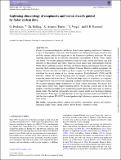Files in this item
Lightning climatology of exoplanets and brown dwarfs guided by Solar system data
Item metadata
| dc.contributor.author | Hodosán, G. | |
| dc.contributor.author | Helling, Ch. | |
| dc.contributor.author | Asensio-Torres, R. | |
| dc.contributor.author | Vorgul, I. | |
| dc.contributor.author | Rimmer, P. B. | |
| dc.date.accessioned | 2016-10-06T13:30:14Z | |
| dc.date.available | 2016-10-06T13:30:14Z | |
| dc.date.issued | 2016-10-01 | |
| dc.identifier | 246545964 | |
| dc.identifier | 7544c197-1e35-44bf-b516-e77d7056e616 | |
| dc.identifier | 84988667401 | |
| dc.identifier | 000383514900043 | |
| dc.identifier.citation | Hodosán , G , Helling , C , Asensio-Torres , R , Vorgul , I & Rimmer , P B 2016 , ' Lightning climatology of exoplanets and brown dwarfs guided by Solar system data ' , Monthly Notices of the Royal Astronomical Society , vol. 461 , no. 4 , pp. 3927-3947 . https://doi.org/10.1093/mnras/stw1571 | en |
| dc.identifier.issn | 0035-8711 | |
| dc.identifier.uri | https://hdl.handle.net/10023/9614 | |
| dc.description | We highlight financial support of the European Community under the FP7 by an ERC starting grant number 257431. RAT thanks the Royal Astronomical Society (RAS) and the Physics Trust of the University of St Andrews for supporting his summer placement at the University of St Andrews. | en |
| dc.description.abstract | Clouds form on extrasolar planets and brown dwarfs where lightning could occur. Lightning is a tracer of atmospheric convection, cloud formation and ionization processes as known from the Solar system, and may be significant for the formation of prebiotic molecules. We study lightning climatology for the different atmospheric environments of Earth, Venus, Jupiter and Saturn. We present lightning distribution maps for Earth, Jupiter and Saturn, and flash densities for these planets and Venus, based on optical and/or radio measurements from the World Wide Lightning Location Network and Sferics Timing and Ranging Network radio networks, the Lightning Imaging Sensor/Optical Transient Detector satellite instruments, the Galileo, Cassini, New Horizons and Venus Express spacecraft. We also present flash densities calculated for several phases of two volcano eruptions, Eyjafjallajökull's (2010) and Mt Redoubt's (2009). We estimate lightning rates for sample, transiting and directly imaged extrasolar planets and brown dwarfs. Based on the large variety of exoplanets, six categories are suggested for which we use the lightning occurrence information from the Solar system. We examine lightning energy distributions for Earth, Jupiter and Saturn. We discuss how strong stellar activity may support lightning activity. We provide a lower limit of the total number of flashes that might occur on transiting planets during their full transit as input for future studies. We find that volcanically very active planets might show the largest lightning flash densities. When applying flash densities of the large Saturnian storm from 2010/11, we find that the exoplanet HD 189733b would produce high lightning occurrence even during its short transit. | |
| dc.format.extent | 21 | |
| dc.format.extent | 5288070 | |
| dc.language.iso | eng | |
| dc.relation.ispartof | Monthly Notices of the Royal Astronomical Society | en |
| dc.subject | Atmospheric effects | en |
| dc.subject | Brown dwarfs | en |
| dc.subject | Jupiter | en |
| dc.subject | Planetary systems | en |
| dc.subject | Planets and satellites: atmospheres | en |
| dc.subject | Planets and satellites: individual: Earth, Venus, Jupiter, Saturn | en |
| dc.subject | QB Astronomy | en |
| dc.subject | QC Physics | en |
| dc.subject | Astronomy and Astrophysics | en |
| dc.subject | Space and Planetary Science | en |
| dc.subject | NDAS | en |
| dc.subject.lcc | QB | en |
| dc.subject.lcc | QC | en |
| dc.title | Lightning climatology of exoplanets and brown dwarfs guided by Solar system data | en |
| dc.type | Journal article | en |
| dc.contributor.sponsor | European Research Council | en |
| dc.contributor.institution | University of St Andrews. School of Physics and Astronomy | en |
| dc.identifier.doi | 10.1093/mnras/stw1571 | |
| dc.description.status | Peer reviewed | en |
| dc.identifier.url | https://arxiv.org/abs/1606.09172 | en |
| dc.identifier.grantnumber | 257431 257431 | en |
This item appears in the following Collection(s)
Items in the St Andrews Research Repository are protected by copyright, with all rights reserved, unless otherwise indicated.

